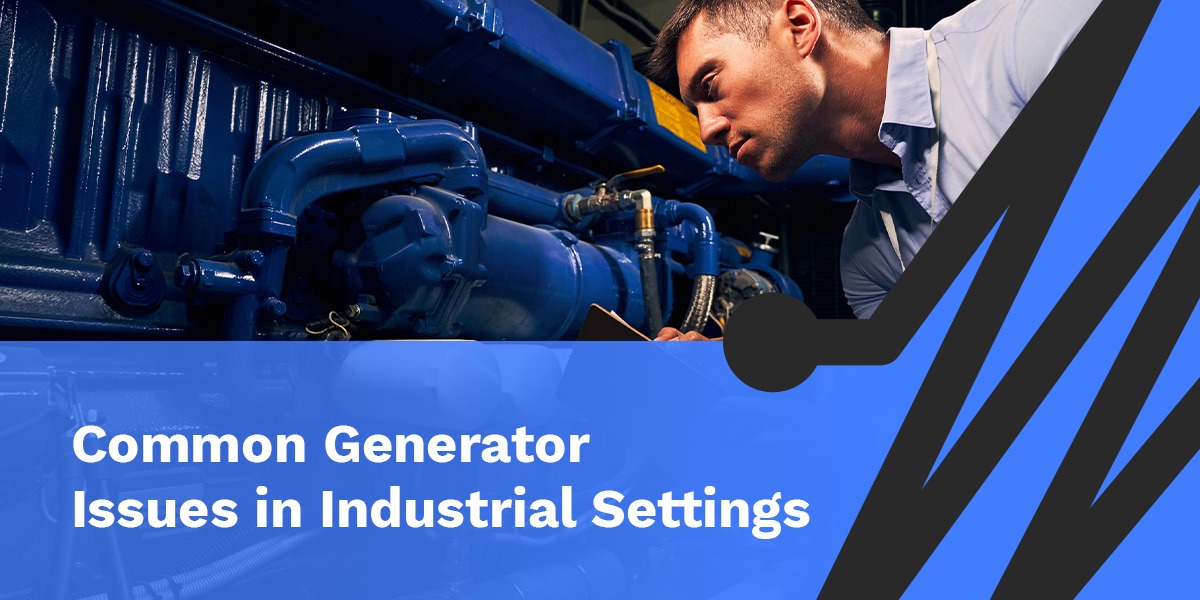
Industrial generators are essential for maintaining operations during emergency power outages. Due to the vital nature of these generators, understanding the potential problems that can occur and how to solve them can reduce downtime and help keep your business running as smoothly and efficiently as possible.
Learn more about troubleshooting common generator issues and how to fix them if your generator displays problems during crucial periods.
This alarm activates when the fuel tank reaches 90%-95% capacity to prevent the tank from being overfilled. If too much fuel is in the tank, the alarm will sound, and you’ll need to reduce the fuel level. Occasionally, the natural thermal expansion of the fuel will trigger the alarm without the tank being above the set capacity. Manually resetting the alarm can correct the issue so the alarm is back in working order.
Oil, fuel and coolant leaks can cause fluid levels to read as low, even after regular fuel refills. During routine maintenance, you can look for leaks</a >, preventing them from growing and causing further damage.
Oil leaks can sometimes result from wet stacking — when lube oil, condensed water, carbon particles, acids and unburned fuel accumulate in the exhaust system. Running the generator with an electrical load once a week can prevent wet stacking. In more severe cases, have a professional generator expert come in and perform a load test to correct the issue.
Wet stacking can also happen with improperly-sized generators. If your generator is larger than your energy needs, it will run with too light of a load. This inefficient running can lead to wet stacking.
The block heater warms the coolant, allowing it to circulate through the engine block and prevent the oil from thickening. Block heaters are necessary for warm and cool climates to keep the oil flowing smoothly and the engine running correctly. When block heater hoses fail, coolant can leak into the rest of the generator. Regularly maintaining and replacing hoses every few years can prevent them from becoming too worn out due to high temperatures.
Low coolant levels can lead to the generator overheating, cracked heads and broken pistons. If you’ve already checked for leaks and refilled the coolant and the generator is still overheating, you may have an additional problem elsewhere. Dirty coolant causing clogs in the radiator core and worn drive hoses and belts could be potential causes.
When lines clog, they restrict the flow of fuel, coolant and oil and prevent the generator from running effectively. Oxidation is a common cause of fuel line clogs — it can cause a buildup of sludge in the lines. Oxidation happens naturally, but performing regular fuel maintenance and treatment will allow you to lengthen the life of your fuel and fight the effects of oxidation.
If your industrial generator fails to start up, check to ensure the generator’s automatic settings are on. Trigger alarms and pushing the emergency stop button can cause automatic controls to turn off, so confirm your generator settings are correct if this occurs.
If you recently had your generator serviced, set the automatic controls before using it to ensure a successful start-up. If the start-up issues persist, check all generator connections. If nothing else looks wrong, contact a professional to help diagnose the problem.
No one wants to experience battery failure during an emergency. To prevent this, regularly clean and tighten cables and connections, remove sulfation from battery plates and ensure that all parts leading to the battery are in working condition before turning on the generator. Knowing the expected service life of your battery and performing monthly monitoring of battery charge rates can help prevent battery shorts and failures.
Several issues could cause your generator to stall while running. Worn or dirty filters can create generator operation issues. Clean air filters bring air into the machine to compress and burn fuel. Clean oil filters catch contaminants and prevent build-ups that wear down the generator’s engine. Regularly check and replace your filters to ensure the machine functions at full capacity.
Another cause of generator stalling may be the spark plugs. In some instances, fouled spark plugs can prevent natural gas generators from producing enough power. Replace worn and cracked spark plugs or units with 100 hours of use. Field inspectors will evaluate spark plugs during checks and change them if necessary.
Once you know the common industrial generator problems you’re likely to encounter, you can better understand what to look for. Performing regular inspections and maintenance will prevent most generator issues from occurring. Routine checks can keep you from experiencing generator failure during emergencies so your business can continue running smoothly.
Natural wear and tear are normal for any industrial generator. Check for damage from pests and weather, and look for any burnt components. If you see worn or damaged parts, replace them to keep your generator ready at all times. Small steps and replacements can keep the unit running at its most efficient for a long time, saving you from losses during blackouts and increasing the cost-effectiveness of the generator.
Some maintenance checks to perform regularly on your generator include:
As Central Valley’s one-stop solution provider, Industrial Electrical Company can reduce downtime and ensure your facility remains powered in emergencies. Our trained field technicians are experts in diagnosing generator issues and will have your unit working smoothly in no time. At Industrial Electrical, our complete generator services include
Try our electric motor efficiency calculator to see how much you could save by improving efficiency. Need our assistance now? We answer the phones 24 hours a day — call us at 209-583-3686 or contact us online today for all your industrial generator needs.

Our motor shop is located right in the Central Valley and can complete any job from total welding services to custom modifications. To learn more about our services, classes and products, contact us online today.